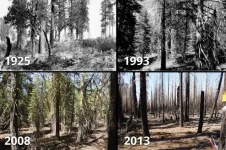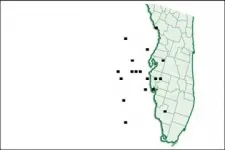(Press-News.org) CORVALLIS, Ore. - Roadless national forests in the American West burn more often and at a slightly higher severity than national forests with roads, but the end result for the roadless forests is greater fire resilience, Oregon State University researchers say.
The findings, published today in Environmental Research Letters, provide a key piece of the puzzle for a region trying to develop better approaches to living with fire in the wake of a 2020 fire season that brought historically disastrous blazes.
Limiting smoke exposure and reducing risk to water supplies, habitat and human infrastructure from huge, uncontrolled fires are important goals of policymakers, said James Johnston, a researcher in the OSU College of Forestry and the study's leader.
Mechanical fuel treatments - piling brush, thinning dense stands of trees, etc. - are a common tool for meeting those goals, but more than half of all fires, including most of the largest ones, burn mainly in roadless areas, where mechanical treatments are usually prohibited.
"The extent of fire where management options are limited makes clear the need to adapt to, rather than overcome, fire," he said.
Differences in fire extent and fire escape - a fire getting beyond the area you think it should stay contained in - are strongly associated with roadless vs. non-roadless management, Johnston said. But the real drivers of fire severity - i.e. tree mortality - are differences in environment and not land use designations.
Trees growing in sites at higher elevations with greater moisture availability and lower temperatures - which describes most of the roadless sites - are generally less fire tolerant than species found in drier, lower-elevation landscapes.
Created in 1905, the U.S. Forest Service oversees nearly 190 million acres of national forests, most of it in the West. The area managed by the USFS makes up one-fifth of all forestland in the United States and 1.5% globally.
Historically, federal legislation typically required the agency to emphasize timber cutting, but the Wilderness Act of 1964 called for the creation of areas where natural conditions would be preserved.
"The act also required the Forest Service to inventory all of its roadless areas not designated as wilderness, pending future action by Congress," Johnston said. "Any of those roadless areas not released for development in the 1970s and '80s ended up becoming an unofficial extension of the wilderness system, and then in 2001, the Roadless Area Conservation Rule generally prohibited building roads and harvesting timber in those areas."
That created two distinct management regimes: an active one featuring road-filled landscapes and a history of recreational development and timber harvesting, and another with no roads, no development and little or no harvesting history. The breakdown is roughly 50-50.
"Human influences are largely absent in roadless areas, the management of which is largely a matter of decisions about how to deal with natural disturbances like wildfire," Johnston said.
Before 1910, frequent low-severity surface fires played a key role in maintaining forests. In the decades since, the comparative lack of fire that resulted from federal policy - in concert with grazing, logging and land-use changes - have caused major structural shifts in older forests as shade-tolerant and fire-intolerant species have moved in.
The policy of fire suppression traces its roots to the Great Fire of 1910, which killed 87 people, destroyed several towns and burned an area roughly the size of Connecticut. The blaze consumed 3 million acres of forest in Idaho, Montana, Washington and British Columbia.
"Wildfire is an important disturbance process that shapes the structure, composition and function of forests, and a better understanding of how passive versus active management relates to fire patterns is critical for managers trying to meet new objectives to restore forests to their natural fire regime," Johnston said. "Over the last three decades, roughly one-third of the roadless landscape experienced fire, while less than one-fifth of the 'roaded' lands did."
That's despite the fact that roadless areas had far fewer ignition events and are generally in regions that are cooler and moister.
"Most of the largest fires that have burned on national forestland in recent years began in roadless areas," said study co-author Jack Kilbride, a Ph.D. student in OSU's College of Earth, Ocean and Atmospheric Sciences. "But evidence suggests that the greater extent of fire in roadless areas has potential to make those landscapes more resilient in the face of climate change. This study really shows the usefulness of satellite data for being able to characterize how fire patterns differ as a function of management."
The legacy of fire suppression includes increased forest density, shifts in species composition and loss of resiliency to fire, drought and insects, the researchers say. But a number of recent studies have shown that forests in wilderness and other roadless areas that have experienced multiple fires are less likely to experience stand-replacing fire and are getting back to the structure and composition they featured prior to white settlement.
"Mechanical thinning, prescribed fire and wildland fire will continue to be used as tools on the 'roaded' landscape," Johnston said. "And without major policy changes, wildland fire will continue to be the primary weapon available in roadless areas. Working together, forest managers and scientists can determine which management objectives are seeing progress, and how much."
INFORMATION:
Hundreds of millions of people live on river deltas around the world, making them central to rich diversity in culture and thriving economies. As deltas face environmental degradation and ongoing climate change, governments have sought ever more drastic measures to prevent flooding and protect society and its infrastructure. But, these policies can harm the natural environment and lead to loss of precious land. Striking a balance between limiting deltaic land loss and maximizing cultural and economic benefit to society is a top priority in sustainability policy.
Researchers ...
With its breathtaking views and striking stature, the Golden Gate bridge certainly deserves its title as one of the modern wonders of the world. Its elegant art deco style and iconic towers offer visitors a once-in-a-lifetime opportunity for astounding photographs. Stretching for almost 2 miles, the Golden Gate serves as a critical gateway, facilitating the exchange of ideas, commodities, and people.
Though not to the same grandiose scale, our brains have similar gateways to connect neurons. These tiny compartments, called synapses, enable the dynamic exchange of information and the formation of neural circuits. To build these circuits, developing ...
Firefighters battling wildfires in the western United States use a variety of suppression tactics to get the flames under control. Prescribed burns, or controlled fires intentionally set to clear shrubs and forest litter before a wildfire ever ignites, can make fire suppression operations almost three times as effective in limiting wildfire severity, according to a new study by researchers from Penn State, the U.S. National Park Service and the U.S. Forest Service.
"A lot happens once a fire starts burning," said Lucas Harris, a postdoctoral scholar in geography at Penn State. "Crews on the ground remove vegetation ...
A survey conducted in March 2020 reports that early concern for COVID-19 outmatched concern for influenza, but respondents may have been less focused on their perceived likelihood of contracting COVID-19 and more concerned with its severe impact on their health. Additionally, when the Centers for Disease Control and Prevention began advising social distancing recommendations in the early months of the pandemic, a majority of adults surveyed believed in the effectiveness of social distancing and intended to follow CDC guidelines. Health agency websites like the CDC were the most frequently identified as "trusted sources" for COVID-19 information, as opposed to substantial ...
More and more companies are using chatbots in customer services. Due to advances in artificial intelligence and natural language processing, chatbots are often indistinguishable from humans when it comes to communication. But should companies let their customers know that they are communicating with machines and not with humans? Researchers at the University of Göttingen investigated. Their research found that consumers tend to react negatively when they learn that the person they are talking to is, in fact, a chatbot. However, if the chatbot makes mistakes and cannot solve a customer's problem, the disclosure triggers a positive reaction. The results of the study were published ...
HOUSTON - The University of Texas MD Anderson Cancer Center's Research Highlights provides a glimpse into recently published studies in basic, translational and clinical cancer research from MD Anderson experts. Current advances include a promising combination therapy for acute myeloid leukemia, understanding mechanisms driving resistance to PARP inhibitors, a therapeutic neoantigen vaccine to treat lung cancer, a novel treatment for triple-negative breast cancer and a new understanding of how telomeres may drive inflammatory bowel disease.
Combination therapy shows promise in mouse models of acute myeloid leukemia
Acute ...
When a hurricane threatens to make landfall, forecasters offer a barrage of informational tools to communicate the risk of it coming through coastal and inland communities, so residents can prepare for its impact. Chief among these tools is the "cone of uncertainty" - a visual depiction of the storm's potential path.
But is the cone doing its job? Studies show that people often misinterpret this popular weather graphic. They don't understand the information it's conveying: the likely path of a storm, and its likelihood to deviate from that path based on historical data. The graphic ...
Americans tend to be far more consumed with national politics than with local politics. As places like Utah, Arizona, Michigan and Maryland gear up to hold local elections this summer and fall, history predicts that they will see an average of 29-37% fewer voters than they would were their elections held "on cycle," in tandem with state and federal elections.
This apparent indifference to local policies can have serious consequences, according to BYU research recently published in the American Political Science Review.
The study found that local governments formed in "off-cycle" years (like 2021) are less responsive to the majority's preferences and more responsive instead to organized interest groups, particularly when the interest groups' desires oppose those of ...
Lessons from Primary Care and Behavioral Health Integration Should Inform Health Care Practices to Identify and Address Patients' Social, Economic Needs
Although interest is accelerating around addressing patients' social and economic needs, effective and sustainable strategies for integrating social care practices into health care delivery have not yet been identified. This paper synthesizes learnings from primary care and behavioral health care integration and translates them into organizing principles with the goal of advancing social care integration practices ...
Heart attack, or myocardial infarction, is one of the leading causes of death worldwide. Although modern surgical techniques, diagnostics and medications have greatly improved early survival from these events, many patients struggle with the long-term effects of permanently damaged tissue, and the 5-year mortality rate remains high. Now, researchers reporting in ACS Nano have developed a minimally invasive exosome spray that helped repair rat hearts after myocardial infarction.
Scientists have explored using stem cell therapy as a way to regrow tissue after a heart attack. But introducing stem cells directly to the heart can be risky because they could trigger an immune response or grow uncontrollably, resulting in a tumor. Therefore, researchers have tried ...






